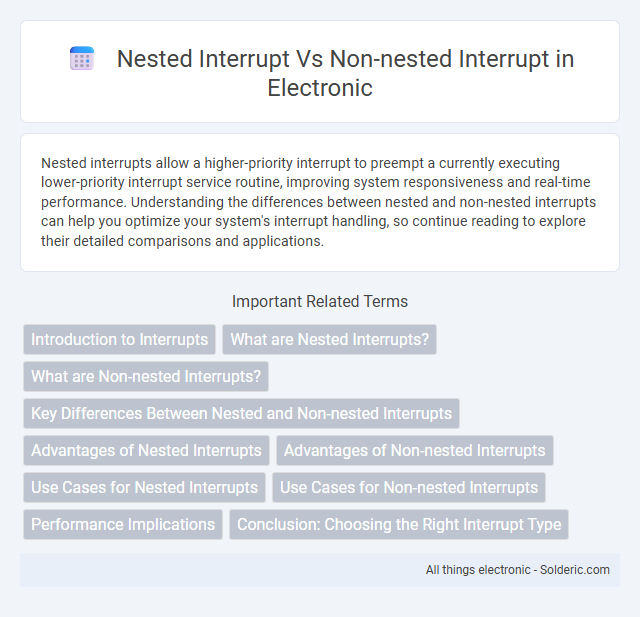Nested interrupts allow a higher-priority interrupt to preempt a currently executing lower-priority interrupt service routine, improving system responsiveness and real-time performance. Understanding the differences between nested and non-nested interrupts can help you optimize your system's interrupt handling, so continue reading to explore their detailed comparisons and applications.
Comparison Table
| Feature | Nested Interrupt | Non-Nested Interrupt |
|---|---|---|
| Interrupt Handling | Allows higher priority interrupts to interrupt lower priority interrupt service routines (ISRs) | Disables all interrupts during ISR execution; no new interrupts until ISR completes |
| Response Time | Faster for high priority interrupts due to preemption | Slower, as all interrupts wait until current ISR finishes |
| Complexity | More complex due to stack management and context saving | Simpler, easier to implement and debug |
| System Overhead | Higher overhead because of multiple context switches | Lower overhead with single context switch per interrupt |
| Use Case | Real-time systems requiring prioritized interrupt handling | Simple or low-priority systems without strict timing requirements |
| Risk | Potential stack overflow and complexity-induced bugs | Reduced risk, easier to maintain system stability |
Introduction to Interrupts
Interrupts are hardware or software signals that temporarily halt the CPU's current operations to address high-priority tasks, enhancing system responsiveness. Nested interrupts allow a higher-priority interrupt to preempt a currently executing interrupt service routine, enabling more critical tasks to be processed without delay. In contrast, non-nested interrupts complete the current interrupt handling before attending to subsequent interrupts, which can lead to slower response times for urgent events.
What are Nested Interrupts?
Nested interrupts allow higher-priority interrupt requests to be serviced before lower-priority ones complete, enabling multiple interrupt levels to be handled efficiently by the CPU. This mechanism saves the state of the current interrupt and switches to the higher-priority interrupt service routine, improving real-time system responsiveness. In contrast, non-nested interrupts disable further interrupt handling until the current interrupt is fully serviced, which can lead to increased latency for critical tasks.
What are Non-nested Interrupts?
Non-nested interrupts refer to an interrupt handling mechanism where the processor disables further interrupts while servicing the current one, ensuring a single interrupt is processed at a time. This method simplifies interrupt management but can lead to higher latency for critical tasks waiting in the queue. Your system's responsiveness may be impacted if multiple interrupts occur simultaneously, as non-nested interrupts delay handling until the current interrupt is fully resolved.
Key Differences Between Nested and Non-nested Interrupts
Nested interrupts allow higher-priority interrupts to preempt currently executing lower-priority interrupts, enhancing system responsiveness and real-time performance. Non-nested interrupts, in contrast, disable other interrupts during execution, causing all pending interrupts to wait until the current one finishes, which can lead to increased latency. Understanding these key differences helps you design interrupt handling strategies that balance complexity and system efficiency.
Advantages of Nested Interrupts
Nested interrupts enhance system responsiveness by allowing higher-priority interrupts to preempt lower-priority ones, improving real-time processing. They optimize CPU utilization by minimizing latency for critical tasks, ensuring prompt handling of urgent events. Nested interrupts also support efficient multitasking in embedded systems, increasing overall system throughput and reliability.
Advantages of Non-nested Interrupts
Non-nested interrupts simplify system design by preventing multiple interrupt requests from disrupting the current process, which ensures predictable and stable execution flow. Your system benefits from reduced complexity in interrupt handling and lower risk of priority inversion or resource conflicts. This leads to easier debugging and improved reliability in time-critical applications.
Use Cases for Nested Interrupts
Nested interrupts are essential in real-time systems where higher-priority tasks must immediately preempt lower-priority ones to ensure timely response, such as in automotive safety controls or medical devices. They allow Your system to handle critical events without delay by temporarily pausing less urgent processes. This capability enhances system reliability and prioritizes urgent interrupt requests effectively.
Use Cases for Non-nested Interrupts
Non-nested interrupts are ideal for simple embedded systems where interrupt handling speed and simplicity are critical, such as in microcontrollers for basic sensor monitoring or single-task applications. They prevent interrupt priority conflicts by disabling further interrupts during execution, ensuring predictable and consistent response times. Your system benefits from non-nested interrupts when real-time operation demands minimal overhead and straightforward interrupt management.
Performance Implications
Nested interrupts allow higher-priority interrupts to preempt lower-priority ones, enhancing system responsiveness and reducing interrupt latency. Non-nested interrupts disable further interrupts during service, simplifying design but potentially increasing response time for urgent tasks. Nested interrupt handling requires more complex stack management and context saving, which may introduce overhead affecting overall performance.
Conclusion: Choosing the Right Interrupt Type
Selecting between nested and non-nested interrupts depends on system requirements for responsiveness and complexity. Nested interrupts allow higher-priority tasks to preempt lower-priority ones, improving real-time performance in critical applications. Non-nested interrupts simplify interrupt handling but may increase latency, making them suitable for less time-sensitive systems.
Nested interrupt vs Non-nested interrupt Infographic

 solderic.com
solderic.com